Mt Ama Dablam Expedition
Ama Dablam is a majestic peak in the Khumbu region of eastern Nepal, standing at 6,812 meters (22,349 feet) with its distinctive pyramid shape. "Ama Dablam" translates to "Mother's Necklace" in the Sherpa language, which refers to its ridges resembling the arms of a mother embracing her child. The climb to Ama Dablam is renowned for its technical difficulty, requiring advanced mountaineering skills in rock and ice climbing, navigating steep ridges, and crossing crevasses. Its strategic location near Mount Everest and other prominent peaks provides breathtaking views of the Himalayan range.
Beyond its physical challenge, Ama Dablam holds cultural significance for the Sherpa community. The mountain is considered sacred, adorned with prayer flags and chortens that reflect the spiritual connection between the locals and the mountain. The expedition typically spans 4-6 weeks, including acclimatization periods and a summit push from Camp 3. Safety is paramount, and climbers are advised to have a well-trained guide or join a reputable mountaineering company.
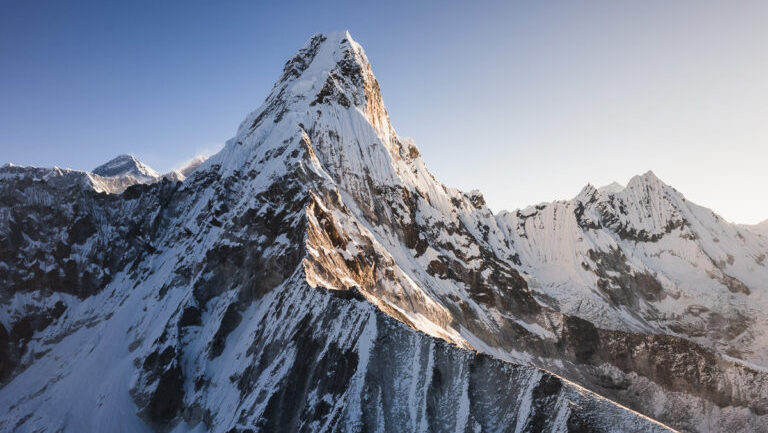
Preparation is a major part of the successful climb. Climbers must have prior mountaineering experience, physical fitness, and proficiency in necessary skills. Acclimatization and knowledge of altitude sickness symptoms are crucial. The journey begins in Kathmandu, where permits are obtained, followed by a flight to Lukla and a trek to Ama Dablam Base Camp. Acclimatization rotations to higher camps allow climbers to adapt to the altitude. The final ascent to the summit provides a rewarding experience and a chance to witness the breathtaking beauty of the surrounding peaks.
An expedition to Ama Dablam offers a unique blend of technical challenge, natural splendor, and cultural immersion. It is an opportunity to test oneself, embrace the Sherpa culture, and create lasting memories in the heart of the Himalayas. However, climbers must approach the climb with respect for the mountain's risks, prioritize safety at all times, and be adequately prepared physically, mentally, and logistically.
Highlights of the Mountain Ama Dablam Expedition
Here are some highlights of the Mt. Ama Dablam Expedition in bullet points:
- Majestic Peak: Mt. Ama Dablam is a stunning peak in the Everest region of Nepal, known for its iconic pyramid-shaped summit and breathtaking beauty.
- Technical Challenge: The expedition offers a thrilling and technical climbing experience, with sections of steep ice and rock, exposed ridges, and challenging terrain that will test climbers' skills and endurance.
- Spectacular Views: Throughout the expedition, climbers are rewarded with spectacular panoramic views of the surrounding Himalayan peaks, including Everest, Lhotse, Nuptse, and Makalu.
- Cultural Experience: The journey begins with a trek through Sherpa villages, providing an opportunity to immerse in the local Sherpa culture, visit monasteries, and witness the unique way of life in the Everest region.
- Sagarmatha National Park: The expedition takes place within the Sagarmatha National Park, a UNESCO World Heritage Site known for its diverse flora and fauna, including rare wildlife like the snow leopard and Himalayan Tahr.
- Acclimatization: The expedition includes strategically planned acclimatization days to help climbers adjust to the high altitude and minimize the risk of altitude-related illnesses.
- Teamwork and Camaraderie: Climbing Mt. Ama Dablam often involves teamwork and collaboration, fostering a sense of camaraderie among climbers and creating lifelong bonds and memories.
- Base Camp Experience: The expedition involves setting up a base camp at approximately 4,570 meters (15,000 feet), offering a unique camping experience amidst the awe-inspiring Himalayan scenery.
- Summit Achievement: Reaching the summit of Mt. Ama Dablam is a significant achievement, a moment of personal triumph, and an opportunity to savor the unparalleled views from the top.
- Adventure of a Lifetime: The Mt. Ama Dablam Expedition is an unforgettable adventure that combines physical and mental challenges, natural beauty, cultural exploration, and the thrill of conquering a magnificent peak in the Himalayas.
History of Mt Ama Dablam Expedition
The history of Mt. Ama Dablam expeditions dates back to 1961 when a New Zealand team led by Sir Edmund Hillary successfully made the first ascent. Since then, Ama Dablam has gained popularity among mountaineers for its challenging routes and striking pyramid shape. Improved technology and equipment have made it more accessible over the years. Many notable expeditions have taken place, adding to its mountaineering legacy. Ama Dablam holds cultural significance for the Sherpa community, and guided expeditions have contributed to the growth of adventure tourism in the region. Today, Ama Dablam continues to be a sought-after destination for experienced climbers seeking a memorable Himalayan experience.

Routes for the Mt Ama Dablam Expedition
There are several established routes for the Mt. Ama Dablam expedition, each offering its own challenges and experiences. Here are some of the commonly climbed routes:
Southwest Ridge
The Southwest Ridge route is the most popular and commonly used route for the Mt. Ama Dablam Expedition. Here are the key features and details of the Southwest Ridge route:
Base Camp: The expedition begins with a trek from Lukla to the base camp of Mt. Ama Dablam, located at approximately 4,570 meters (15,000 feet). The base camp serves as the starting point for the climb.
Camp 1: From the base camp, climbers ascend towards Camp 1, situated at around 5,700 meters (18,700 feet). The route involves traversing rocky terrain and negotiating steep sections.
Yellow Tower: One of the iconic features of the Southwest Ridge route is the Yellow Tower. Climbers encounter this distinctive rock tower, which requires technical climbing skills to ascend.
Camp 2: After surpassing the Yellow Tower, climbers continue their ascent to Camp 2, located at approximately 6,100 meters (20,000 feet). Camp 2 offers a crucial resting point and allows for further acclimatization.
The Mushroom Ridge: Beyond Camp 2, climbers traverse the Mushroom Ridge, named for its mushroom-shaped rock formations. This section requires careful navigation and is known for its exposure.
Camp 3: Camp 3 is situated at an altitude of around 6,400 meters (21,000 feet). This camp is strategically positioned to provide a final resting place before the summit push.
Summit Push: From Camp 3, climbers make the challenging and technical push towards the summit of Mt. Ama Dablam. The final stretch includes negotiating steep snow slopes, icy sections, and rocky terrain.
Summit: The summit of Mt. Ama Dablam stands at 6,812 meters (22,349 feet). Reaching the summit is a moment of great accomplishment, offering breathtaking views of the surrounding Himalayan peaks.
It is important to note that the Southwest Ridge route requires climbers to possess solid mountaineering skills, including proficiency in using climbing equipment, glacier travel, and technical climbing techniques. Safety measures such as fixed ropes and anchors are often in place to assist climbers along the route. Experienced guides or mountaineering agencies can provide detailed guidance and support throughout the expedition on the Southwest Ridge route of Mt. Ama Dablam.
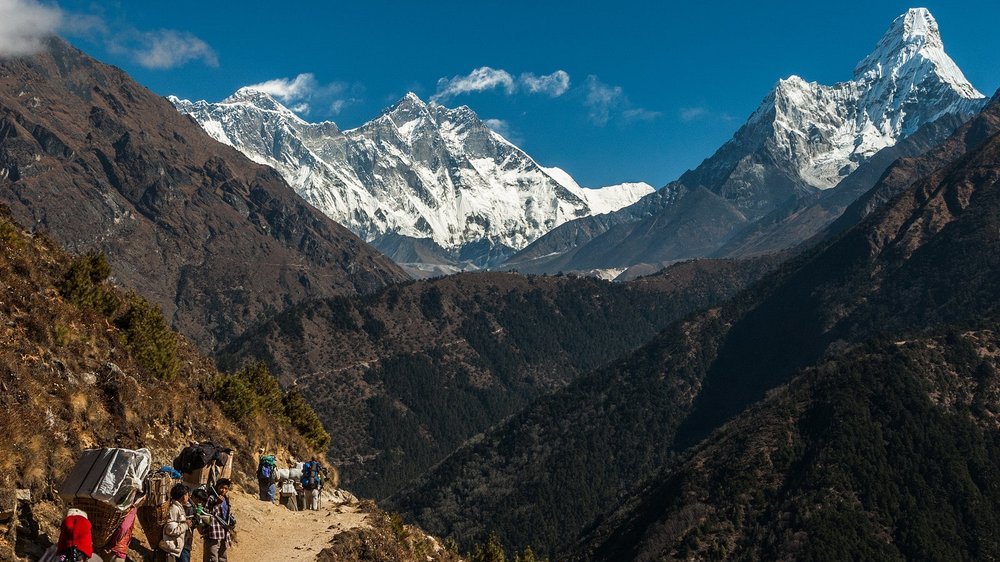
Northwest Ridge
The Northwest Ridge presents a more challenging and less commonly climbed route. It begins from the same base camp as the Southwest Ridge but diverges towards the left. The route involves mixed climbing, steep snow slopes, and exposed sections. It requires advanced mountaineering skills and is suitable for experienced climbers seeking a more demanding ascent.
North Ridge
The North Ridge is a challenging and rarely climbed route on Ama Dablam. It starts from the Mingbo Glacier and ascends through steep snow and ice slopes. The route demands technical ice-climbing abilities and a high level of mountaineering experience. It offers a remote and adventurous experience but requires careful planning and preparation.
It's important to note that route conditions and popularity may vary from season to season. Additionally, climbers should consult with experienced guides or mountaineering companies for up-to-date information on route suitability, equipment requirements, and safety considerations. Choosing the right route depends on your climbing abilities, experience level, and personal goals for the expedition..
Mountain views seen during the Mt Ama Dablam Expedition
During the Mt. Ama Dablam expedition, climbers are treated to breathtaking mountain views in the Khumbu region of the Himalayas. Here are some of the prominent peaks and stunning landscapes that can be witnessed along the way:
Mt. Everest: As the highest peak in the world, Mt. Everest dominates the skyline. During the Ama Dablam expedition, climbers often get magnificent views of Everest, witnessing its majestic presence and iconic summit.
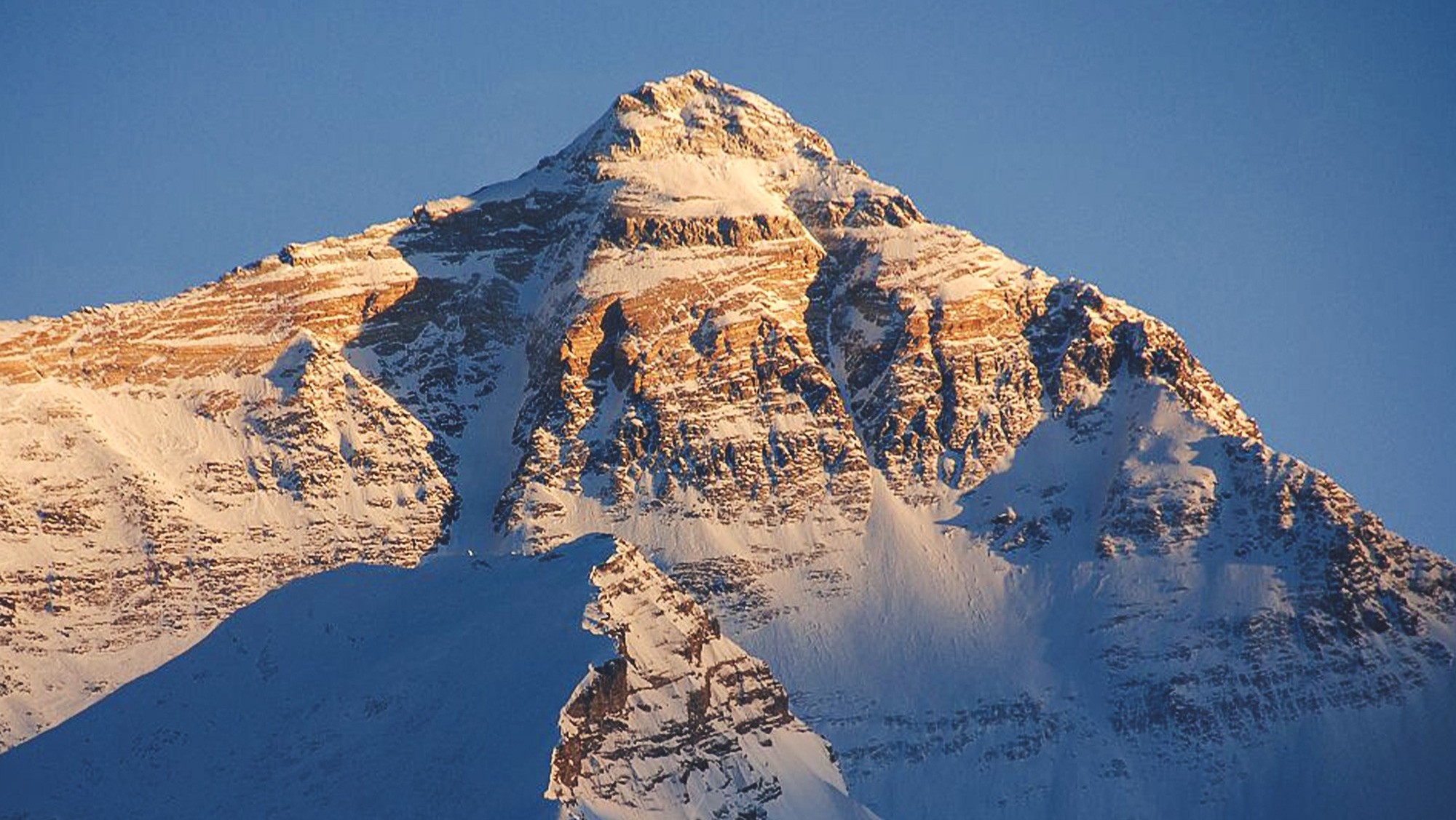
Lhotse: Located just south of Everest, Lhotse is the fourth-highest mountain in the world. Its impressive icy slopes and sharp ridges can be seen during the expedition, offering a glimpse into the neighboring peaks.
Makalu: Situated southeast of Ama Dablam, Makalu is the fifth-highest mountain in the world. With its distinct pyramid shape, climbers can enjoy distant views of this imposing peak.
Cho Oyu: Located on the Nepal-Tibet border, Cho Oyu is the sixth-highest mountain in the world. During the expedition, climbers may catch sight of this majestic peak, which stands as a striking backdrop to the surrounding landscape.
Khumbu Valley: The journey to Ama Dablam takes climbers through the scenic Khumbu Valley. This picturesque valley is adorned with beautiful Sherpa villages, terraced fields, and flowing rivers, creating a captivating and serene environment.
Glacier Views: Throughout the expedition, climbers may encounter several glaciers, including the Khumbu Glacier and the Mingbo Glacier. These immense icy formations offer a surreal and awe-inspiring sight, adding to the overall beauty of the landscape.
Himalayan Landscapes: The entire region surrounding Ama Dablam is blessed with stunning Himalayan landscapes. Towering peaks, deep valleys, dramatic ridgelines, and vast snowfields create a mesmerizing panorama that captivates climbers at every turn.
These mountain views and landscapes provide a constant reminder of the grandeur and beauty of the Himalayas during the Mt. Ama Dablam expedition. They serve as a source of inspiration and awe, making the journey even more unforgettable for those undertaking the climb.
How Difficult Is The Mt Ama Dablam Expedition
The Mt. Ama Dablam expedition is considered a challenging and technically demanding climb. It requires a high level of mountaineering skills, physical fitness, and experience in alpine climbing. Here are some factors that contributed to the difficulty of the expedition:
Technical Climbing: Ama Dablam features a combination of technical climbing challenges, including rock, ice, and mixed terrain. Climbers must navigate steep ridges, and vertical sections, and traverse challenging sections such as the Yellow Tower. Proficiency in various climbing techniques, including rock climbing, ice climbing, and the use of climbing equipment such as ropes, crampons, and ice axes, is necessary.
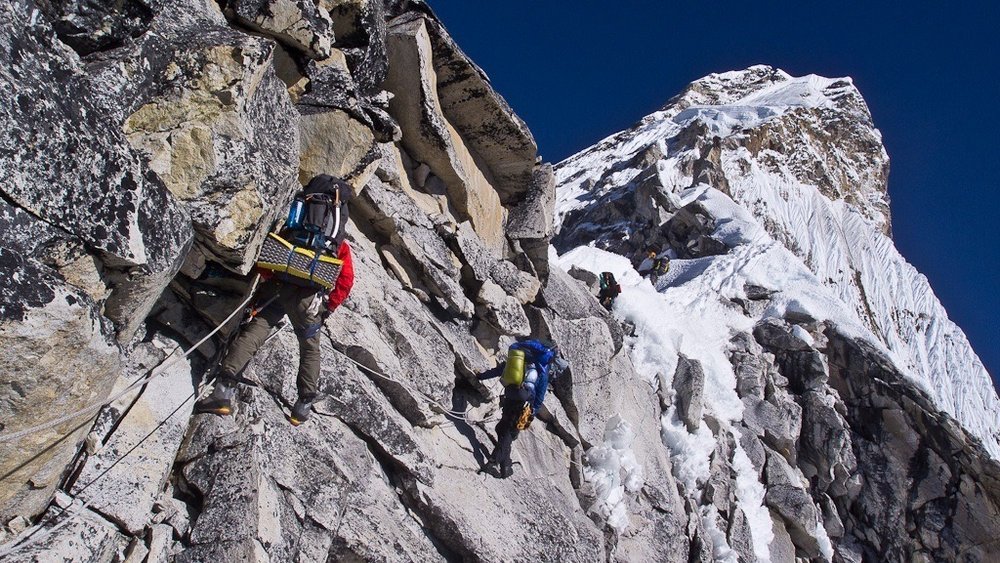
Altitude: Ama Dablam stands at an elevation of 6,812 meters (22,349 feet), and the effects of high altitude can significantly impact climbers. Acclimatization is crucial to allow the body to adapt to the thin air and reduce the risk of altitude sickness. The higher altitude increases the physical exertion required, and the thin air can affect energy levels and decision-making abilities.
Weather Conditions: The weather in the Himalayas can be unpredictable and harsh, posing additional challenges during the expedition. High winds, extreme cold, and sudden weather changes can impact climbing conditions and increase the difficulty of the ascent. It is essential to be prepared for adverse weather conditions and have the flexibility to adjust plans accordingly.
Steep and Exposed Terrain: Ama Dablam features steep and exposed terrain, requiring climbers to have a good sense of balance, strong climbing techniques, and the ability to handle exposure to heights. Climbers may encounter narrow ridges, vertical sections, and exposure to significant drops, necessitating focus, concentration, and precise footwork.
Length of the Expedition: The Mt. Ama Dablam expedition typically spans 4-6 weeks, including acclimatization periods and the summit push. Endurance and mental resilience are crucial, as climbers need to maintain their physical and mental strength over an extended period in challenging conditions.
How to prepare for the Mt Ama Dablam Expedition
To prepare for the Mt. Ama Dablam expedition, focus on physical fitness by incorporating cardiovascular exercises and strength training. Gradually increase your endurance and strength levels over time. Acclimatization is crucial, so plan for gradual altitude gain and spend time at higher elevations before attempting the climb. Familiarize yourself with mountaineering skills, including rock and ice climbing, rope handling, and crevasse rescue techniques. Seek guidance from experienced mountaineers or hire a reputable guide service to enhance your skills and knowledge. Pack appropriate gear, including high-quality clothing, boots, and equipment suitable for alpine conditions. Mental preparation is also important to stay focused, motivated, and adaptable during the challenging expedition..
Permits for the Mt Ama Dablam Expedition
Permits are required for the Mt. Ama Dablam expedition, and climbers must obtain them through the Nepal Mountaineering Association (NMA) and the Department of Tourism (DOT). Here are the permits necessary for the expedition:
Climbing Permit: The Climbing Permit is issued by the NMA and is mandatory for all climbers attempting Mt. Ama Dablam. The permit is specific to the individual climber and is valid for a specified period. The permit fee varies depending on the season and the number of climbers in the expedition.
Sagarmatha National Park Entry Permit: Mt. Ama Dablam is located within the Sagarmatha National Park, a protected area in the Everest region. All climbers must obtain the Sagarmatha National Park Entry Permit, which allows access to the park. The permit can be obtained from the entry point in Monjo or at the Nepal Tourism Board Office in Kathmandu.
TIMS Card: The Trekker's Information Management System (TIMS) card is required for all trekkers and climbers in Nepal. It serves as a registration and tracking system to ensure the safety and security of travelers. TIMS cards can be obtained from the Nepal Tourism Board Office or through authorized trekking agencies in Kathmandu or Pokhara.
It's important to note that permit requirements and fees may vary, and it's essential to stay updated with the latest regulations from the NMA and DOT.
Best Season For Mt Ama Dablam Expedition
Spring Season (April to May)
The spring season is one of the most popular times for the Mt. Ama Dablam expedition. It offers relatively stable weather conditions with clear skies, lower precipitation, and milder temperatures. The improved weather allows for excellent visibility, providing climbers with breathtaking views of the surrounding Himalayan peaks. The spring season also presents a higher likelihood of a summit window, providing climbers with favorable conditions for a successful ascent. However, it's important to note that the spring season attracts more climbers, leading to busier base camps and climbing routes.
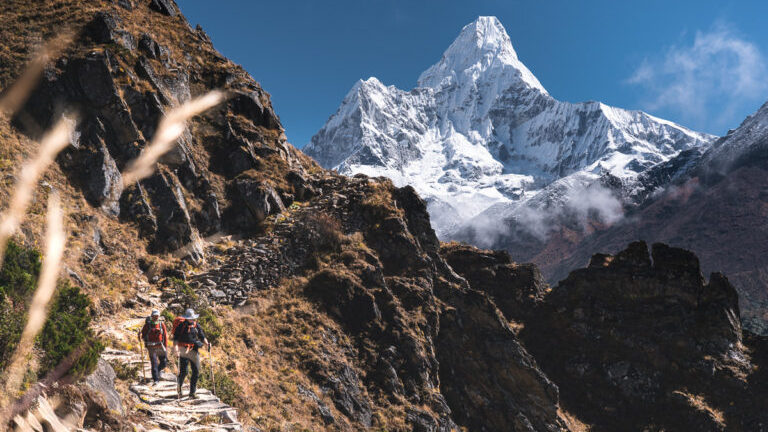
Summer Season (June to August)
The summer season, also known as the monsoon season, is not recommended for the Mt. Ama Dablam expedition. This period is characterized by heavy rainfall, frequent cloud cover, and increased avalanche risk. The challenging weather conditions and reduced visibility make climbing hazardous and significantly limit the chances of a successful summit bid. It's generally advised to avoid the summer season for the expedition.
Autumn Season (September to November)
The autumn season is another highly recommended period for the Mt. Ama Dablam expedition. During this season, the weather is generally stable, with clear skies, reduced rainfall, and cooler temperatures. The visibility is excellent, offering panoramic views of the stunning Himalayan landscape. The autumn season also provides a higher chance of a summit window, allowing climbers to undertake their ascent in favorable weather conditions. One advantage of the autumn season is the relatively lower number of climbers on the mountain, resulting in a quieter and less congested climbing experience.
Winter Season (December to February)
The winter season is the coldest time of the year in the Everest region, making it an extremely challenging time for the Mt. Ama Dablam expedition. Harsh weather conditions, including heavy snowfall, strong winds, and extremely cold temperatures, create treacherous climbing conditions. The limited daylight hours and icy terrain further add to the difficulty. Due to the extreme weather and heightened risks, the winter season is not recommended for most climbers, except for highly experienced mountaineers seeking extreme winter climbing challenges.
It's important to carefully consider the weather conditions, crowd levels, and personal climbing abilities when choosing the best season for the Mt. Ama Dablam expedition.
Accommodation and Meals During The Mt Ama Dablam Expedition
During the Mt. Ama Dablam expedition, climbers have various accommodation and meal options at different stages of the journey. Here are the common types of accommodation and meals available:
Accommodation
Kathmandu
Before the expedition begins, climbers typically stay in hotels or guesthouses in Kathmandu. There is a wide range of options available, from budget accommodations to luxury hotels, providing comfortable rooms, meals, and amenities. It's recommended to choose a reputable hotel in a convenient location.
Tea Houses
Along the trekking route to Ama Dablam, there are several tea houses or lodges available in villages such as Namche Bazaar, Tengboche, and Pangboche. These tea houses offer basic but comfortable accommodation, usually consisting of shared rooms with twin beds or dormitory-style accommodation. Tea houses also provide meals, including local and international dishes, and hot beverages. However, facilities may be more basic at higher altitudes.
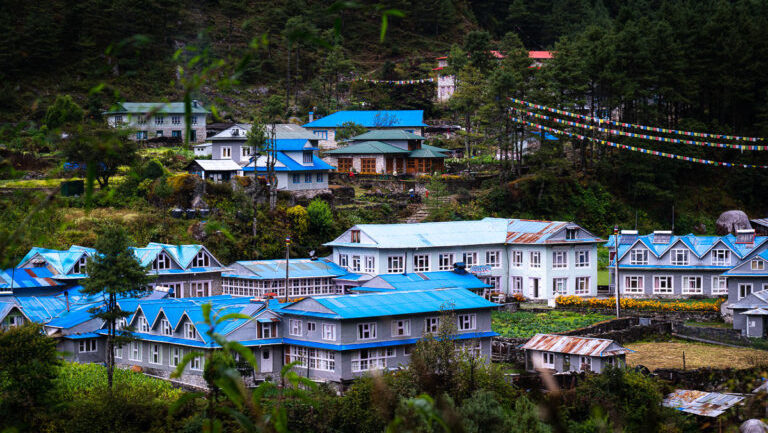
Base Camp
Once climbers reach the base camp of Ama Dablam, they set up their own expedition tents for accommodation. Base camp facilities may include dining tents, kitchen facilities, and communal areas for climbers to socialize and relax. Climbers need to bring their own camping gear, including tents, sleeping bags, and other necessary equipment.
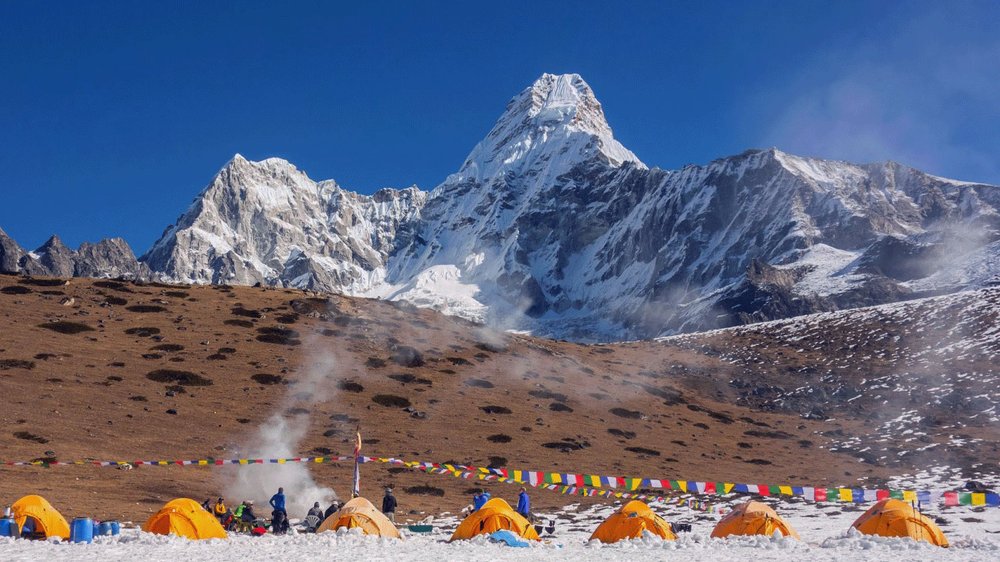
High Camps
During the ascent of Ama Dablam, climbers typically establish high camps at strategic points along the route. These high camps serve as temporary resting and acclimatization points before climbers make their final summit push. Accommodation at high camps is in the form of tents that climbers bring with them. The camps are set up to provide shelter and protection from the elements.
It's important to note that accommodation options at higher altitudes, such as tea houses and high camps, may have limited facilities and may be more basic compared to those at lower elevations. It's essential to be prepared for rustic conditions and bring appropriate gear for the expedition.
Meals
During the Mt. Ama Dablam expedition, climbers can expect a variety of meal options at different stages of the journey. In Kathmandu, before starting the expedition, climbers can enjoy a diverse range of cuisines at local restaurants, including Nepali, Indian, Tibetan, and international dishes. Once on the trekking route, tea houses or lodges in villages such as Namche Bazaar, Tengboche, and Pangboche provide meals for trekkers and climbers. The menu options at tea houses are typically limited but include staples like dal bhat, noodles, soups, and snacks such as momos. Hot beverages like tea, coffee, and hot chocolate are also available. At the base camp, climbers are responsible for their own food arrangements and usually bring a combination of pre-packaged meals, energy bars, and snacks. High camps rely on the climbers' own food supplies brought from the base camp, which are lightweight and quick to prepare. It is crucial to plan and pack sufficient food supplies that provide the necessary nutrition and energy for the duration of the expedition. Maintaining a balanced diet and proper hydration is essential for optimal performance and acclimatization at high altitudes. Consulting with a nutritionist or experienced mountaineers can provide valuable insights on planning meals and ensuring adequate nutrition during the expedition.
Travel Insurance for the Mt Ama Dablam Expedition
Having travel insurance is highly recommended for the Mt. Ama Dablam expedition. It is an essential aspect of preparing for the journey as it provides financial protection and peace of mind in case of unforeseen events or emergencies. Here are some key points to consider regarding travel insurance for the expedition:
Coverage: Ensure that your travel insurance policy provides coverage for mountaineering expeditions, including high-altitude climbing. Verify that it covers medical expenses, emergency evacuation and rescue, trip cancellation or interruption, and loss or damage to personal belongings.
High-Altitude Coverage: Check if the policy specifically includes coverage for high-altitude activities, as some standard travel insurance policies may have altitude restrictions or exclusions. The Mt. Ama Dablam expedition involves climbing to significant heights, so it is crucial to have adequate coverage for such activities.
Medical Evacuation and Rescue: Make sure your insurance policy includes coverage for emergency medical evacuation and rescue. In the event of a serious injury or medical emergency, prompt evacuation to a lower altitude or a medical facility is crucial. This coverage ensures that the costs associated with helicopter rescue or evacuation are taken care of.
Trip Cancellation and Interruption: Consider a policy that provides coverage for trip cancellation or interruption. It can protect your investment in case you need to cancel or cut short the expedition due to unforeseen circumstances, such as personal illness, family emergencies, or unexpected weather conditions.
Adventure Sports Coverage: Confirm if the travel insurance policy covers adventure sports or hazardous activities. Mountaineering falls under this category, and it's important to have coverage specifically for this type of activity.
Policy Exclusions and Limitations: Thoroughly read and understand the policy terms, conditions, exclusions, and limitations. Be aware of any restrictions related to pre-existing medical conditions, coverage limits, deductibles, and claim procedures. It's essential to choose a policy that aligns with your specific needs and provides comprehensive coverage for the expedition.
Insurance Provider Reputation: Select a reputable insurance provider with experience in covering mountaineering expeditions and adventure activities. Research customer reviews, seek recommendations, and ensure that the insurance company has a track record of providing reliable coverage and excellent customer service.
Before purchasing travel insurance, carefully evaluate your specific needs, the risks associated with the Mt. Ama Dablam expedition, and the coverage options available. It's advisable to consult with an insurance professional or experienced mountaineers who can offer guidance on selecting the most suitable travel insurance policy for your expedition.
Checklist for the Mt Ama Dablam Expedition
Preparing for the Mt.Ama Dablam expedition requires careful planning and packing. Here's a checklist to help you organize your gear and essentials:
Clothing
- Insulated down jacket
- Waterproof and windproof shell jacket
- Insulated pants or climbing pants
- Base layers (thermal tops and bottoms)
- Fleece or softshell jackets
- Trekking pants
- Moisture-wicking t-shirts
- Warm hats and gloves
- Thermal socks and hiking socks
- Gaiters
- Sunglasses with UV protection
- Sun hat or cap
Footwear
- Mountaineering boots (sturdy and insulated)
- Hiking boots or trekking shoes
- Gaiters
- Crampons (compatible with your boots)
- Trekking sandals or comfortable camp shoes
Climbing and Technical Gear
- Climbing harness
- Helmet
- Ice axe
- Crampons
- Carabiners and quickdraws
- Prusik cords
- Ascenders or jumars
- Climbing ropes (dynamic and static)
- Climbing slings and cordage
- Mountaineering backpack
Camping Gear
- Tent (appropriate for high-altitude conditions)
- Sleeping bag (rated for sub-zero temperatures)
- Sleeping pad or insulated mat
- Headlamp with extra batteries
- Camping stove and fuel
- Cooking utensils and mess kit
- Water bottles or hydration system
- Water purification tablets or filter
Personal Items
- Personal medications and first aid kit
- Sunscreen and lip balm (with high SPF)
- Toiletries (toothbrush, toothpaste, biodegradable soap, etc.)
- Wet wipes or hand sanitizer
- Travel towel
- Trekking poles
- Camera and spare batteries
- Portable power bank for charging electronic devices
- Money, identification documents, and travel permits
Miscellaneous
- Map and compass
- Guidebooks or route descriptions
- Mountaineering gloves
- Multi-tool or knife
- Repair kit (including duct tape and sewing kit)
- Snacks and high-energy food
- Cash for emergencies or buying supplies on the trail
Remember to pack light but ensure you have all the necessary gear and essentials for a safe and successful expedition.
Tips for the Mt Ama Dablam Expedition
Here are some tips to help you prepare for Mt. Ama Dablam Expedition:
- Prioritize physical fitness and endurance training.
- Plan your itinerary with gradual ascents and rest days for proper acclimatization.
- Develop and enhance your mountaineering skills through training and courses.
- Prepare yourself mentally for the challenges and uncertainties of the climb.
- Invest in high-quality mountaineering equipment and gear.
- Maintain a well-balanced diet and stay hydrated throughout the expedition.
- Foster good communication and teamwork within your climbing group.
- Follow safety protocols and be aware of potential hazards.
- Practice responsible mountaineering and respect the natural environment.
- Have contingency plans in place for unexpected circumstances.
These tips will help you better prepare for the Mt. Ama Dablam Expedition and increase your chances of a safe and successful climb.
FAQ (Frequently Asked Questions) for in Nepal Mt Ama Dablam Expedition
Q: How difficult is the Mt. Ama Dablam Expedition?
A: The Mt. Ama Dablam Expedition is considered a challenging and technical climb. It requires mountaineering experience, good physical fitness, and proficiency in using climbing equipment. The route includes steep ice and rock sections, exposed ridges, and technical climbing sections, making it suitable for experienced climbers.
Q: What permits do I need for the Mt. Ama Dablam Expedition?
A: To climb Mt. Ama Dablam, you will need the following permits:
- Sagarmatha National Park Entry Permit: This permit allows entry into the Everest region and can be obtained in Kathmandu or Monjo.
- Khumbu Rural Municipality Permit: This permit is required to access the Khumbu region and can be obtained in Lukla or Monjo.
- Climbing Permit: This is a special permit issued by the Nepal Mountaineering Association (NMA) specifically for climbing Mt. Ama Dablam.
Q: What is the best season for the Mt. Ama Dablam Expedition?
A: The best seasons for Mt. Ama Dablam Expeditions are spring (April to May) and autumn (September to November). These seasons offer stable weather conditions, clear skies, and relatively milder temperatures. However, spring tends to be busier with more climbers, while autumn offers quieter trails and less crowded climbing routes.
Q: How long does the Mt. Ama Dablam Expedition?
A: The duration of the Mt. Ama Dablam Expedition can vary depending on several factors, including climber experience, weather conditions, acclimatization schedule, and the chosen route. Generally, the expedition takes around 4 to 6 weeks, including trekking to the base camp, acclimatization periods, establishing high camps, and making a summit attempt.
Q: Do I need previous mountaineering experience to climb Mt. Ama Dablam?
A: Yes, previous mountaineering experience is highly recommended for the Mt. Ama Dablam Expedition. It is important to have prior experience in high-altitude climbing, and glacier travel, and proficiency in using mountaineering equipment such as crampons, ice axes, and ropes. Strong rock and ice climbing skills are essential due to the technical nature of the route.
Q: Do I need a guide for the Mt. Ama Dablam Expedition?
A: While it is possible to climb Mt. Ama Dablam independently, having a qualified and experienced guide is highly recommended. A guide can provide valuable support, local knowledge, assistance with logistics, and ensure safety during the expedition. They can also offer guidance on route finding, technical skills, and help with the necessary permits and paperwork.
Q: Can I combine the Mt. Ama Dablam Expedition with other treks or climbs in the Everest region?
A: Yes, it is possible to combine Mt. Ama Dablam Expedition with other treks or climbs in the Everest region. Popular options include incorporating the Everest Base Camp trek or the trek to Gokyo Lakes. However, it is important to factor in the additional time and logistics required for such combinations.
Q: Are there fixed ropes on the climbing route of Mt. Ama Dablam?
A: Yes, fixed ropes are usually installed on the climbing route of Mt. Ama Dablam. These fixed ropes help climbers with safety and assist in navigating through the technical sections of the climb. However, it is still necessary to have the appropriate mountaineering skills and experience to climb safely.
Q: What is the success rate of summiting Mt. Ama Dablam?
A: The success rate of summiting Mt. Ama Dablam varies each year and depends on various factors such as weather conditions, climbers' experience, and team dynamics. On average, the success rate is around 50-60%, but it can vary significantly. Adequate physical fitness, mountaineering skills, and proper acclimatization greatly contribute to increasing the chances of a successful summit.
Q: Is there helicopter rescue available in case of emergencies?
A: Yes, helicopter rescue services are available in the Everest region, including the Ama Dablam area, for emergency evacuations. However, it is important to note that helicopter rescues are subject to weather conditions and feasibility. Additionally, the cost of helicopter rescues is typically not covered by travel insurance and can be quite expensive.
Q: Are there any age restrictions for the Mt. Ama Dablam Expedition?
A: There are no specific age restrictions set by the Nepal Mountaineering Association (NMA) for the Mt. Ama Dablam Expedition, climbers are generally expected to be physically fit and have the necessary mountaineering skills and experience. It is recommended to consult with the guiding company or expedition organizer to determine their specific requirements.
Similarly other 6000-meter peaks for Climbing and Expedition Packages in Nepal
Singu Chuli Peak Climbing (6,501 m)
Pisang Peak Climbing (6,091 m)
Chulu West Peak Climbing (6,419 m)
Mera Peak Climbing (6,476 m)
Island Peak Expedition (6,160 m)
8000-meter Mountain Expedition in Nepal
Makalu Expedition (8,463m)
Manaslu Expedition (8,163 m)
Kanchenjunga Expedition (8,586 m)
Lhotse Expedition (8,516 m)
Mt. Everest Expedition (8848.86 m)
Dhaulagiri Expedition (8,167 m)
7000-meter peaks for Climbing and Expedition in Nepal
Gangapurna Expedition (7,455 m)
Pumori Expedition (7,145 m)
Tilicho Peak Expedition (7,134 m)
Annapurna South Expedition (7,219 m).
If you need any further information, please contact us by email: at [email protected], Phone: at +977- 985 100 5129 (WhatsApp)
#Tags
Tripadvisor
5.0928 reviewsGoogle
4.8114 reviewsFacebook
4.1 recommend44 ReviewsTrustpilot
4.1 Great(5 reviews)- Trusted by50K plus traveller




